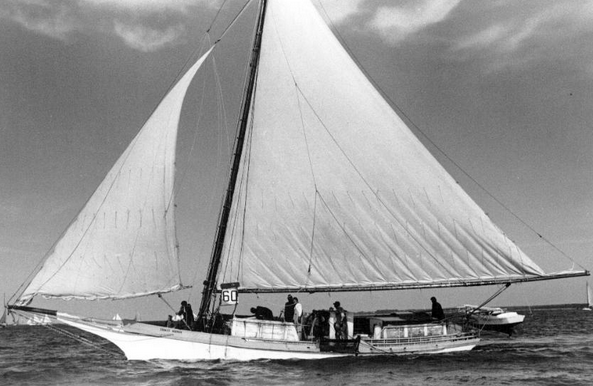
Sail Number:
Type: Skipjack
LOA: 48’3″ / 14.70m – LOD: 47’6″ / 14.47m – Beam: 15’4″ / 4.67m – Draft: 4’0” / 1.22m – Design Number: – Designer: Chesapeake Bay Style – Rig: Jib-headed mainsail – Current Owner: Chesapeake Bay Foundation – Year Launched: 1902 – Built By: Otis Lloyd, Salisbury, Maryland – Hull Material: Wood – Cross-planked construction – Displacement: 7 tons – Dredge Number: 60 – USCG Number: 117187 – Maryland Historical Trust: Website
Chesapeake Bay Foundation: Educational Program
Photo credit: M.C. Wootton, 10/1983
Historical:
Stanley Norman is significant as being one of the 35 surviving traditional Chesapeake Bay skipjacks and a member of the last commercial sailing fleet in the United States. Out of a fleet of hundreds of skipjacks that worked Bay waters in the early years of this century today only this small number remain to carry on the tradition of working sail. STANLEY NORMAN is of interest as being one of the older skipjacks still dredging in the Chesapeake fleet. She was built in 1902 in Salisbury, Maryland, following traditional Bay-area design and construction methods. The vessel is one of the 19 surviving working skipjacks to have been built previous to 1912 and, like most of the skipjacks, has been extensively rebuilt, a process that extended over four years from 1976-1980, and was well documented by the owner and restorer, Ed Farley of Bozman, Maryland. The vessel is particularly finely finished and is used for summer charters as well as for winter dredging. She is an example of how an older vessel, near abandonment, can be restored to useful working life–a process common to wooden vessels of all eras, but particularly well documented in this case. STANLEY NORMAN was sold to the Chesapeake Bay Foundation in 1990, and moved to Annapolis as a teaching vessel. Although damaged by fire on December 9, 2003, the fire was contained in the cabin and the vessel did not sustain major damage.
Description: – This vessel is a 47.5′ long, two-sail bateau, or V-bottomed deadrise type of centerboard sloop, commonly referred to as a skipjack. She has a beam of 16′, a depth of 4′ at the stern with the centerboard up, and a registered tonnage of 7 tons. She was built in Bay style using cross-planked construction in 1902 in Salisbury, Maryland, for the oyster dredging fleet. The vessel’s keel is original and of yellow pine but between 1976 and 1980 much of the vessel was rebuilt, a process which was extremely well documented. She carries a typical skipjack rig–a jib-headed mainsail laced to the boom and carried on hoops at the 65′ spruce mast, and a single, large, self-tending jib with a club on its foot. The vessel is painted white. In shape, the vessel has a longhead bow and square stern. She has a straight stem, with an extra brace flying from the end of the longhead to the bow planking. Her square transom stern is “tucked” underwater–in other words, the chine meets the waterline, causing some drag. This is an unusual feature, as most skipjacks have a high tuck where the chine meets the transom. The rudder is hung outboard on pintles mounted on the flat, raking transom and on the skeg. The hull is of cross-planked construction, with some atypical features resulting from her recent rebuilding. These include the addition of two strongbacks and knees added amidships to strengthen the hull. Rebuilding also saw the addition of new mast partners, a new bow, and enlarged cabin and hatches, but the basic deck layout remains the same as the original. The hull is sheathed with metal–annealed yellow brass–at the waterline. Decks are of oak and there are metal-sho rub-rails on the sides of the hull beneath the sheer. The hull is painted white, as are the decks. The spars are bright and there are bright and gray accents on the cabin. Topsides are gray with the name STANLEY NORMAN in black applied letters on the sheer plank at the bows. The vessel is flush-decked. Deck structures (in their original layout) from the stern forward include: a trunk cabin with a slide, providing access to the main cabin; a small deck hatch; a plywood box over the winders; a cargo hatch in two sections, with a high coaming; and a forward cuddy with a slide, giving access to the head and to storage space below. Fittings for oystering include rollers, winders, a winder engine, dredges, and pushboat suspended on davits over the stern. A pinrail surrounds the decks, 16″ high aft, 10″ height forward, but open at the dredge rollers. There is an additional pipe rail around the stern quarter, extending forward as far as the rigging except for the work area. The main cabin, which is particularly finely finished is equipped with lanterns; a barometer and chronometer; two horseshoe lockers for sitting; bunks; a stove; table; and miscellaneous supplies and equipment. The mast has considerable rake and is set up with double shrouds of steel cable with turnbuckles and chain rather than the more traditional deadeyes. Other-rigging includes a forestay, jibstay, topping lift, and lazyjacks. The bowsprit is set up with a double chain bobstay and two bowsprit shrouds as well as its extra wooden flying brace. The long boom is jawed to the mast. The jib is made self-tending with a horse of 1 1/2″ pipe set across the foredeck.
The Wall of Remembrance – The Owners, Crew & Notable Guest:
Owner/Guardian: Chesapeake Bay Foundation
